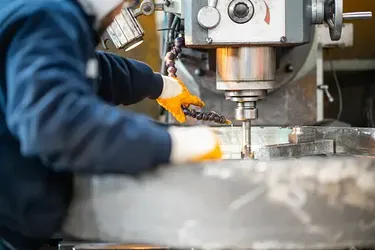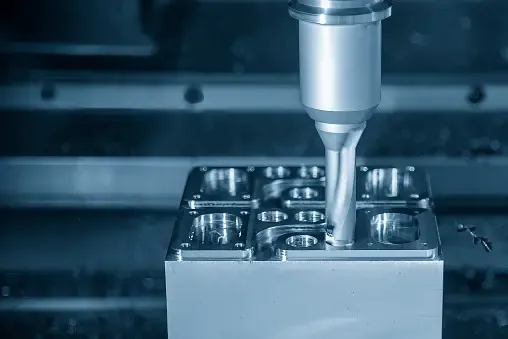What is a Milling Machine?
Milling machines are a staple in the world of manufacturing and machining. These versatile machines are used to shape solid materials, such as metal, wood, and plastic, by removing excess material with rotary cutters. They are essential tools for producing parts with precise dimensions and intricate details.
Understanding Milling Machines
At its core, a milling machine operates on the principle of rotating a cutting tool against a stationary workpiece. The cutting tool, known as a mill or milling cutter, is mounted on a spindle, which can move in various directions. This allows the milling machine to perform a wide range of operations, including cutting, drilling, and contouring.
Milling machines come in different types, each suited for specific tasks and materials. The two primary categories are vertical milling machines and horizontal milling machines.
Vertical Milling Machines
In a vertical milling machine, the spindle axis is oriented vertically. This configuration is ideal for tasks that require precision and fine details, such as creating slots, holes, and intricate patterns. Vertical milling machines are commonly used in the aerospace, automotive, and electronics industries, where accuracy is paramount.
Horizontal Milling Machines
Conversely, horizontal milling machines have a horizontally oriented spindle. This setup is better suited for heavy-duty tasks and large-scale material removal. Horizontal milling machines are often used in industries like construction and shipbuilding, where large and sturdy parts are produced.
Key Components of a Milling Machine
Understanding the main components of a milling machine can help you grasp how these machines operate and their capabilities. Here are some of the essential parts:
Base and Column: The base provides stability to the machine, while the column supports the spindle and other components.
Spindle: The spindle holds and rotates the milling cutter.
Table: The workpiece is clamped onto the table, which can move in multiple directions to position the workpiece accurately.
Knee: The knee supports the table and can be adjusted vertically.
Ram: The ram extends from the column and can be adjusted horizontally to position the spindle.
Types of Milling Cutters
Milling machines utilize various cutters, each designed for specific tasks. Some common types of milling cutters include:
End Mill: A versatile cutter used for drilling, slotting, and contouring.
Face Mill: Ideal for creating flat surfaces and removing large amounts of material quickly.
Ball Nose Cutter: Perfect for creating complex 3D shapes and contours.
Slot Drill: Designed for cutting slots and keyways.
Milling Operations
Milling machines can perform a wide range of operations, making them indispensable in many industries. Some of the most common milling operations include:
Face Milling: Producing a flat surface on the workpiece.
Peripheral Milling: Cutting along the edges of the workpiece.
Slot Milling: Creating slots or grooves in the workpiece.
Drilling: Making precise holes in the workpiece.
Contour Milling: Shaping the workpiece into complex profiles and contours.
Applications of Milling Machines
The versatility of milling machines makes them suitable for various applications across different industries. Here are some examples:
Automotive Industry: Milling machines are used to produce engine parts, transmission components, and intricate molds for car bodies.
Aerospace Industry: Precision is crucial in aerospace manufacturing, and milling machines play a vital role in creating components like turbine blades, wing parts, and landing gear.
Electronics Industry: Milling machines are used to fabricate circuit boards, connectors, and enclosures for electronic devices.
Construction Industry: Large-scale milling machines are used to create structural components, such as beams and columns, for buildings and bridges.
Advantages of Milling Machines
Milling machines offer numerous advantages, contributing to their widespread use in various industries:
Precision: Milling machines can produce parts with high accuracy and tight tolerances.
Versatility: These machines can perform a wide range of operations, from simple drilling to complex contouring.
Efficiency: Milling machines can quickly remove large amounts of material, making them ideal for both prototyping and production.
Automation: Modern milling machines often come with computer numerical control (CNC) capabilities, allowing for automated and repeatable operations.
CNC Milling Machines
The advent of CNC technology has revolutionized milling machines. CNC milling machines use computer programs to control the movement of the spindle and table, ensuring precise and repeatable operations. This automation allows for greater efficiency, reduced human error, and the ability to produce complex parts with ease.
Maintaining a Milling Machine
Proper maintenance is crucial to ensure the longevity and performance of a milling machine. Regular maintenance tasks include:
Lubrication: Keeping moving parts well-lubricated to reduce wear and tear.
Cleaning: Removing chips and debris from the machine to prevent damage and ensure smooth operation.
Inspection: Regularly checking for signs of wear and replacing worn components as needed.
Calibration: Ensuring that the machine is properly calibrated to maintain accuracy.
Choosing the Right Milling Machine
Selecting the appropriate milling machine for your needs depends on various factors, including the material you are working with, the complexity of the parts you are producing, and your budget. Here are some tips for choosing the right milling machine:
- Identify Your Requirements: Determine the specific tasks you need the milling machine to perform and choose a machine that meets those needs.
- Consider the Workpiece Size: Ensure that the machine's table size and spindle travel can accommodate the size of the workpieces you will be working on.
- Evaluate CNC Capabilities: If precision and automation are essential, consider investing in a CNC milling machine.
- Budget: Milling machines come in a wide range of prices, so set a budget and find a machine that offers the best value for your investment.
Conclusion
Milling machines are indispensable tools in the manufacturing and machining industries, offering precision, versatility, and efficiency. Whether you are producing intricate parts for the aerospace industry or large structural components for construction, a milling machine can help you achieve your goals with accuracy and speed. By understanding the different types of milling machines, their components, and their applications, you can make informed decisions and choose the right machine for your needs.




